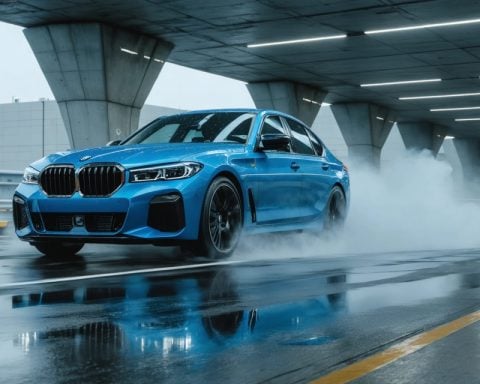The automotive industry is on the brink of a transformation with the emergence of the digital grille panel market. This state-of-the-art technology is set to redefine not just vehicle aesthetics but also functionality and interactivity. Unlike traditional grille designs, these digital iterations leverage advanced materials and smart technology, offering a blend of lighting and sensor integration.
From luxury to mainstream, automotive manufacturers are rapidly adopting digital grille panels to enhance brand identity and improve vehicle aerodynamics. This shift aligns perfectly with the electric vehicle (EV) movement, where the absence of traditional engines allows for more creative front-end designs. Manufacturers now have the opportunity to use digital displays to convey important information, such as charging status or driver assistance alerts, directly on the vehicle’s grille.
Recent trends indicate that consumer demand for personalized and smart automotive features is fueling investments in this technology. These grilles promise an interactive user experience, capable of adaptability and dynamic display, providing both aesthetic allure and infotainment. The technology also supports advanced driver-assistance systems (ADAS), integrating seamlessly with other onboard sensors to improve safety.
Industry experts predict that by 2030, the digital grille panel market will become a standard feature across all vehicle classes, pushing the boundaries of what is possible in vehicular design and function. As the automotive world gears up for a digital future, these panels represent a significant step toward more connected and intelligent transportation solutions.
The Green Revolution: How Digital Grille Panels are Shaping the Future of Transportation
The advent of digital grille panels in the automotive sector isn’t merely a shift in vehicle design; it’s a transformative force with profound implications for our environment, humanity, and the global economy. This innovative technology, evolving alongside the burgeoning electric vehicle (EV) market, presents opportunities that resonate far beyond surface aesthetics.
Environmental Impact:
The integration of digital grille panels harmonizes with the growing emphasis on sustainability and reduced carbon emissions. By replacing conventional grille designs, these panels contribute to improved aerodynamic performance. Better aerodynamics translate to increased energy efficiency, particularly for EVs, which directly correlates with decreased energy consumption and a smaller environmental footprint. This development can propel the shift towards lower-emission vehicles, a vital step in combating climate change.
The digital grille technology also supports the larger infrastructure suitable for energy-efficient transportation. The integration with ADAS not only enhances safety but can potentially lead to optimized traffic flow and decreased fuel wastage. As this technology becomes widespread, we expect to see substantial positive shifts in urban planning and energy consumption, ultimately reducing environmental degradation.
Humanity and the Global Economy:
Digital grille panels offer a new dimension of interactivity and personalization for drivers, fundamentally changing the driving experience. With their ability to convey critical information directly on the vehicle’s front, they enhance user convenience and vehicle communication capabilities. This level of personalization and engagement meets modern consumers’ demand for smart technology, fostering a more connected society.
The economic implications are significant: as the demand for advanced automotive technology rises, so does the need for specialized labour, manufacturing processes, and technological expertise. The digital grille panel market may catalyze job creation in tech sectors related to design, production, and automotive software development. Furthermore, as these panels become standard across all vehicle classes, they could decrease costs through economies of scale, making cutting-edge technology accessible to a broader audience.
Connections to the Future of Humanity:
Looking ahead, digital grille panels underscore a more significant trend toward intelligent and sustainable transportation systems. As we transition to smarter cityscapes, vehicles equipped with advanced digital technologies will be crucial in seamlessly integrating personal mobility with broader urban infrastructures. This integration supports the development of smart cities, where transportation is efficient, connected, and environmentally friendly.
In essence, digital grille panels represent more than just a technological advancement; they are a glimpse into how innovation can reshape industries and pave the path for eco-friendly and interconnected global transportation systems. As we embrace these changes, we take steps toward a future where humanity thrives alongside technological and environmental advancements, ensuring a balanced coexistence with our planet.
The Future of Vehicle Design: How Digital Grille Panels Are Revolutionizing the Automotive Industry
As the automotive landscape evolves, the emergence of the digital grille panel market heralds a new era of innovation and functionality in vehicle design. This technology is set to unlock a myriad of opportunities, driving advances in both car aesthetics and utility.
Key Innovations and Features
The digital grille panel stands out for its ability to integrate advanced materials with lighting and sensor technology, paving the way for enhanced vehicle interactivity. Key features include:
– Dynamic Display Capabilities: Capable of showing real-time information like charging status and navigation alerts, these grilles provide an interactive and customized driving experience.
– Sensor Integration: Seamlessly working with advanced driver-assistance systems (ADAS), the digital grille enhances safety by supporting additional sensors for obstacle detection and more.
– Aesthetic and Functional Flexibility: Designers can explore unprecedented front-end designs, aligning with the sleeker profiles of electric vehicles.
Use Cases and Applications
Digital grille panels find use in various automotive segments, offering advantages in both luxury and mainstream models. Here are notable applications:
– Electric Vehicles (EVs): The absence of traditional engine configurations in EVs allows for more innovative grille designs, which can improve aerodynamics and energy efficiency.
– Brand Communication: Automakers can use these panels to reinforce brand identity through custom light patterns and logos.
– Personalization: Consumers can personalize their vehicle’s appearance with dynamic grille displays that can change based on preference or driving mode.
Market Trends and Predictions
Consumer demand for smart and personalized vehicle features fuels the growth of the digital grille panel market. Industry trends indicate:
– By 2030, digital grille panels could become a standard feature across all types of vehicles, ushering in a new norm in automotive design.
– Increasing collaborations between tech companies and automakers to leverage advanced material science and software capabilities for more integrated solutions.
– Expansion of features to include weather and traffic updates, connected directly to the vehicle’s grille display.
Pros and Cons of Digital Grille Panels
As with any cutting-edge technology, digital grille panels present both benefits and challenges:
Pros:
– Enhanced interactivity and customization
– Improved vehicle safety through sensor integration
– Supports the aerodynamic designs of modern EVs
Cons:
– Higher production and repair costs compared to traditional grilles
– Potential for increased vulnerability in harsh weather conditions
– Security risks associated with connectivity features
Conclusion
Digital grille panels are more than just a cosmetic upgrade—they represent a leap forward in smart automotive design. As automotive manufacturers continue to innovate, these grilles promise to deliver a blend of style, safety, and intelligence, shaping the future of transportation.
For further information on innovations in the automotive industry, explore the latest developments at major automaker websites, such as Toyota, where cutting-edge technology meets engineering excellence.













